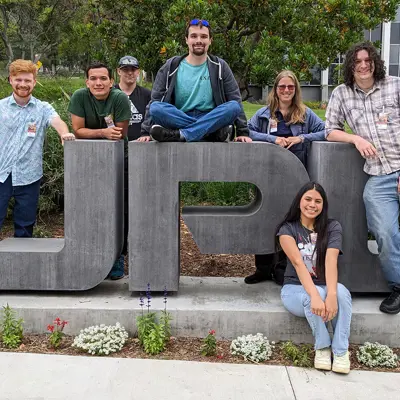
June 20, 2023
Six USI students are spending time this summer in Pasadena, California, not for a sunny vacation, but to utilize the NASA Jet Propulsion Laboratory (JPL) at the California Institute of Technology to test a project the group has been working on since October 2022.
Mechanical engineering major Kassidon Hatfield; electrical engineering majors Briston Bundy, Melanie Cedeno and Miguel Pinto; civil engineering major Derrick Thompson and physics major James Hunnicutt traveled with Dr. Jenna Kloosterman, Assistant Professor of Engineering and Physics, to take measurements of a new Terahertz frequency amplifier designed by JPL. The goal for the six students is to put the amplifier to the test by using optics they designed on campus.
 To create the optics needed to test the amplifier, the students designed a block with two elliptical mirrors. During the test, the first mirror on the block will reflect the Terahertz (THz) source onto the amplifier, which will then reflect the signal back to the block’s second mirror. This second mirror then reflects the signal onto a detector.
To create the optics needed to test the amplifier, the students designed a block with two elliptical mirrors. During the test, the first mirror on the block will reflect the Terahertz (THz) source onto the amplifier, which will then reflect the signal back to the block’s second mirror. This second mirror then reflects the signal onto a detector.
“The elliptical mirrors have two foci points, allowing the incoming and outgoing beams to be focused at two different distances,” explains Kloosterman. “This allows the source, amplifier and detector to have different focal lengths.”
 The point of the amplifier, she adds, is to increase the amplitude of the incoming sky signal, decreasing the necessary time astronomers need to look at a source. The optics the students manufactured were created at the Applied Engineering Center on the USI campus and polished by the students using fine grit sandpaper and aluminum polish.
The point of the amplifier, she adds, is to increase the amplitude of the incoming sky signal, decreasing the necessary time astronomers need to look at a source. The optics the students manufactured were created at the Applied Engineering Center on the USI campus and polished by the students using fine grit sandpaper and aluminum polish.
“The scientific goal of the entire project is to develop better instruments to measure and study the star formation process, which is traced by atoms and molecules that radiate in the Terahertz region of the electromagnetic spectrum,” explains Kloosterman. “THz frequency light oscillates once every 10-12 seconds. This frequency is below visible and infrared light on the electromagnetic spectrum, but higher than microwave.”
Another exciting prospect about the project, she adds, is that it could be used on future balloon and space missions conducted by NASA.
The students began this project in October 2022 and met weekly during the 2023 Spring Semester to discuss papers and designs. Tests were conducted at JPL during the week of June 12 and Kloosterman says the group hopes to have results soon.
